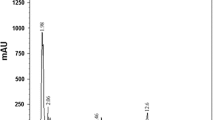Summary
Incubation with MNS at a concentration of 2×10−5 M inhibits 51.7±15.6% of the GSH-px activity in hemolysates, while concentrations ranging between 5×10−5 and 1×10−4 M lead to 100% inhibition. 1×10−4 M MNS in hemoglobin free enzyme solution results in 70% inhibition. The incubation of hemolysates and Hb free GSH-px solution with menadione in concentrations ranging between 2 and 4×10−4 M results in 44 to 70% inhibition. The inhibition appears to be of the non-competitive type and not to be reversed by dialysis. Though MNP at a concentration of 2×10−2 M does not inhibit GSH-px both in hemolysates and Hb-free GSH-px preparations. Na2S2O5 at concentrations of 1×10−3 M produces 50% inhibition of GSH-px. The accumulation of H2O2 caused by the presence of the autoxidable menadione and MNS and by the inhibition of GSH-px might impair the GSH-mediated protective mechanism against oxidative damage in the erythrocytes. Consequently, further oxidation of hemoglobin and of SH groups of the red cell membrane could lead to hemolysis.
Zusammenfassung
Die Inkubation mit MNS in einer Konzentration von 2×10−5 M hemmt die GSH-px-Aktivität in Hämolysaten zu 51,7% (±15,6%), während Konzentrationen von 5×10−5 und 1×10−4 M zu einer vollständigen Hemmung führen. Hämoglobinfreie Enzymlösungen werden durch 1×10−4 M MNS nur zu 70% gehemmt.
Inkubationen von Hämolysaten und Hb-freien GSH-px-Lösungen mit Menadion von 2 bzw. 4×10−4 M führt zu 44%iger bzw. 70%iger Hemmung. Diese Hemmung scheint nicht kompetitiv zu sein und ist durch eine Dialyse nicht reversibel.
MNP hemmt dagegen selbst bei 2×10−2 M die GSH-px weder in Hämolysaten noch in Hb-freien Präparationen.
Na2S2O5 ergibt bei 1×10−3 M eine 50%ige Hemmung der GSH-px.
Die Akkumulation von H2O2, die sowohl durch das autoxidable Menadion und MNS als auch durch eine Hemmung der GSH-px hervorgerufen sein kann, könnte den durch GSH bewirkten Schutz vor oxidativer Schädigung in den Erythrocyten verschlechtern. Somit kann eine Oxidation des Hämoglobins und der SH-Gruppen in der Zellmembran zur Hämolyse führen.
Similar content being viewed by others
References
Allison, A. C.: Danger of vitamin K to newborn. Lancet1955 I, 669.
Ansbacher, S., Corwin, W. C., Thomas, B. G. H.: Toxicity of menadione, menadiol and esters. J. Pharmacol. exp. Ther.75, 111 (1942).
Beutler, E., Duron, O., Kelly, B. M.: Improved method for the determination of blood glutathione. J. Lab. clin. Med.61, 882 (1963).
—— Srivastava, S. K.: The efflux of GSSG from human erythrocytes. In Metabolism and Membrane permeability of erythrocytes and thrombocytes. 1st International Symposium, Vienna, June 17–20, 1968, p. 91. Stuttgart: Georg Thieme 1968.
Boivin, P., Galand, C., Hakim, J., Rogé, J., Gueroult, N.: Anémie hémolytique avec déficit en glutathion-peroxydase chez un adult. Enzym. biol. clin.10, 68 (1969).
Cohen, G., Hochstein, P.: Glucose-6-phosphate dehydrogenase and detoxification of hydrogen peroxide in human erythrocytes. Science134, 1756 (1961).
—— —— Glutathione peroxidase: the primary agent for the elimination of hydrogen peroxide in erythrocytes. Biochemistry2, 1420 (1963).
—— —— Generation of hydrogen peroxide in erythrocytes by hemolytic agents. Biochemistry3, 895 (1964).
Gasser, C.: Heinz body anemia and related phenomena, J. Pediat.54, 673 (1959).
Gross, R. T., Bracci, R., Rudolph, N., Schroeder, E., Kochen, J. A.: Hydrogen peroxide toxicity and detoxification in the erythrocyte of newborn infants. Blood29, 481 (1967).
Horecker, B. L., Smyrniotis, P. Z.: 6-phosphogluconie dehydrogenase. In: Methods in enzymology, vol. I, p. 323 (eds. Colowick, S. P., and Kaplan, N. O.). New York: Acad. Press 1955.
Jacob, H. S., Jandl, J. H.: Effects of sulphydril inhibition on red blood cells. I. Mechanism of hemolysis. J. clin. Invest.41, 779 (1962).
Lineweaver, H., Burk, D.: The determination of enzyme dissociation constants. J. Amer. chem. Soc.56, 658 (1934).
Lucey, J. F., Dolan, R. G.: Hyperbilirubinemia of newborn infants associated with the parenteral administration of a vitamin K analogue to the mothers. Pediatrics23, 553 (1959).
Löhr, G. W., Waller, H. D.: Glucose-6-Phosphat-Dehydrogenase (Zwischenferment). In: Methoden der enzymatischen Analyse (H. U. Bergmeyer, Hrsg.). Weinheim/Bergstraße: Chemic-Verlag 1962.
Mills, G. C.: Hemoglobin catabolism. I. Glutathione peroxidase, an erythrocyte enzyme which protects hemoglobin from oxidative breakdown. J. biol. Chem.229, 189 (1957).
—— Randall, H. P.: Hemoglobin catabolism. II. The protection of hemoglobin from oxidative breakdown in the intact erythrocyte. J. biol. Chem.232, 589 (1958).
Necheles, T. F., Boles, T. A., Allen, D. M.: Erythrocyte glutathione peroxidase deficiency and hemolytic disease of the newborn infant. J. Pediat.3, 319 (1968).
—— Maldonado, N., Barquet-Chediak, A., Allen, D. M.: Homozygous erythrocyte glutathione-peroxidase deficiency, clinical and biochemical studies. Blood33, 164 (1969).
Oski, F. A., Naiman, J. L.: Hematologic problems in the newborn, p. 79. Philadelphia and London: W. B. Saunders Co. 1966.
Racker, E.: Glutathione reductase (liver and yeast). In: Methods in enzymology, vol. II, p. 722 (eds. Colowick, S. P., and Kaplan, N. O.). New York: Acad. Press 1955.
Tarlov, A. R., Brewer, G. J., Carson, P. E., Alvin, A. S.: Primaquine sensitivity. Glucose-6-phosphate dehydrogenase deficiency: An inborn error of metabolism of medical and biological significance. Arch. intern. Med.109, 137 (1962).
Zinkham, W. H.: An in vitro abnormality of glutathione metabolism in erythrocytes from normal newborns: mechanism and clinical significance. Pediatrics23, 18 (1959).
—— The selective hemolytic action of drugs: clinical and mechanistic considerations. J. Pediat.70, 200 (1967).
Author information
Authors and Affiliations
Rights and permissions
About this article
Cite this article
Vetrella, M., Barthelmai, W. Studies on drug-induced hemolysis: Effects of menadione and its water soluble preparations on the glutathione peroxidase of human erythrocytes. Klin Wochenschr 50, 234–238 (1972). https://doi.org/10.1007/BF01486527
Issue Date:
DOI: https://doi.org/10.1007/BF01486527




